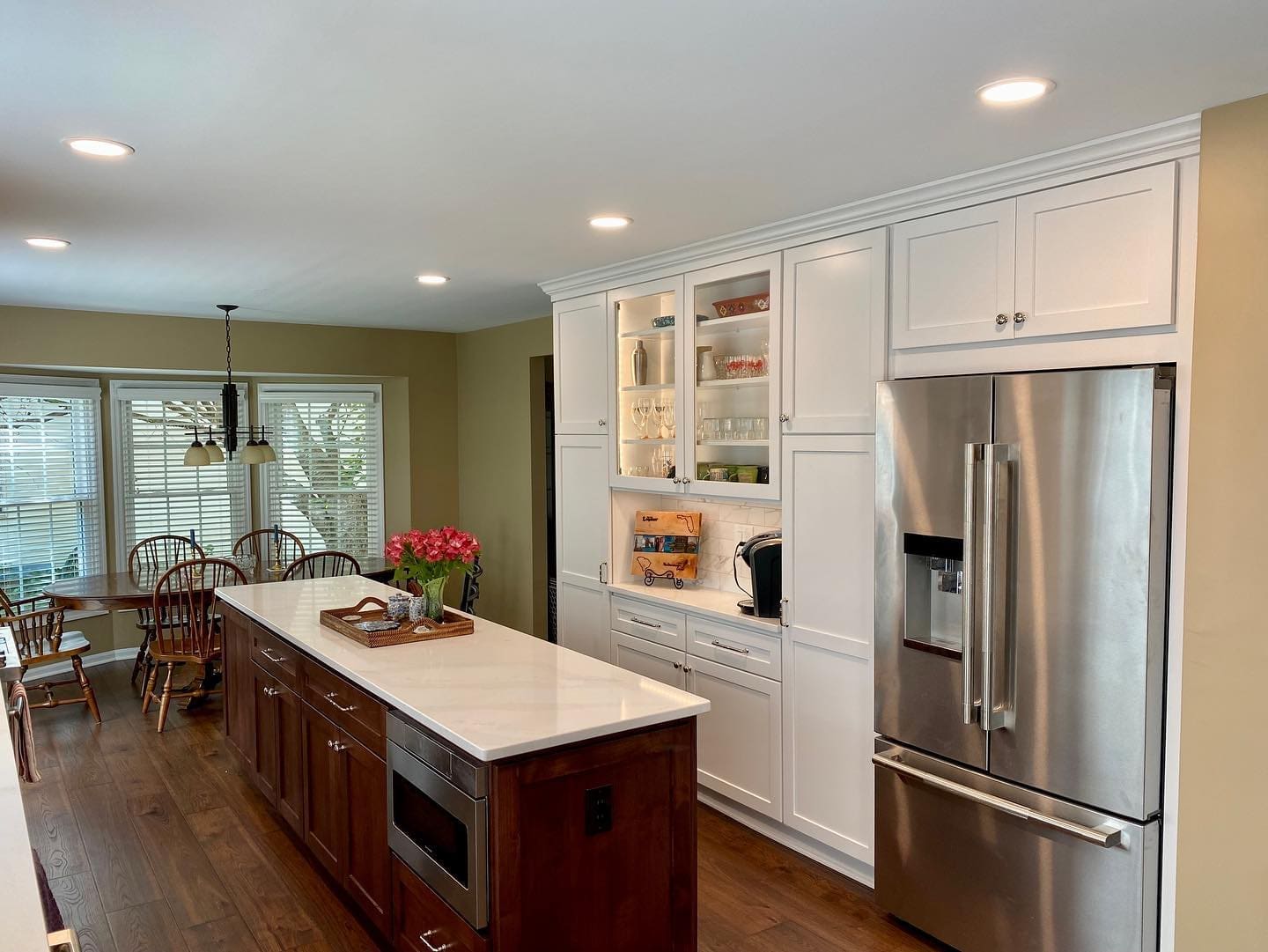 For most folks, open kitchen wall space is a limited commodity and, therefore, a very valuable medium for tying-in your kitchen decorating theme. Backsplashes, for example may receive a finish that directly works in conjunction with the countertop and may be an area that is covered for service reasons rather than for decorating purposes. In such cases, the remaining areas of open wall space in kitchens become valuable templates which can serve to enhance the thematic essence of the entire kitchen. These wall spaces are often segmented and divided by cabinetry and appliances which, by virtue of layout, lend themselves to be addressed individually or identically to one another. A designer may choose to utilize a pronounced wall for accent purposes if the kitchen design indicates; and the designer may also choose to subdue these areas in lieu of more provocative decorating elsewhere in the room. In either scenario, the available wall space in a kitchen is a great means to entertain the personal tastes of homeowner while sharply coordinating with the overall balance of the new space by incorporating a kitchen wall covering.
For most folks, open kitchen wall space is a limited commodity and, therefore, a very valuable medium for tying-in your kitchen decorating theme. Backsplashes, for example may receive a finish that directly works in conjunction with the countertop and may be an area that is covered for service reasons rather than for decorating purposes. In such cases, the remaining areas of open wall space in kitchens become valuable templates which can serve to enhance the thematic essence of the entire kitchen. These wall spaces are often segmented and divided by cabinetry and appliances which, by virtue of layout, lend themselves to be addressed individually or identically to one another. A designer may choose to utilize a pronounced wall for accent purposes if the kitchen design indicates; and the designer may also choose to subdue these areas in lieu of more provocative decorating elsewhere in the room. In either scenario, the available wall space in a kitchen is a great means to entertain the personal tastes of homeowner while sharply coordinating with the overall balance of the new space by incorporating a kitchen wall covering.
Introducing Texture and ‘Interest’ to these walls
One of the challenges that a professional interior decorator faces when putting together a kitchen theme is the careful consideration of visual texture and ‘interest’. The predominant visual of most new kitchens is an overabundance of ‘shine’ and ‘smooth’ as denoted by new wood cabinetry, pristine countertops, immaculate sinks and faucets, etc. While this may seem like an ideal picture in your mind, it really isn’t–it needs to have more of a visual balance. This visual balance is created by introducing texture into the space; and kitchen walls are ideal for this intervention. Some of the more simple methods of introducing a needed interruption of texture may be the use of finely woven or relief-embossed wallpaper, or having your contractor trowel a single wall area in a decorative stucco-type finish, which can be painted as an accent area or kept to match the other walls’ color.
Adding ‘interest’ into the kitchen space is typically designated to one particular wall. The concept of ‘interest’ is that it is a deliberate decorating element that draws immediate attention, but may also melt into the general nuance of the area. In some respects it may first appear that this element looks out of place, that it doesn’t really belong; but much the opposite is true. A prime example may be seen in a more contemporary kitchen setting whereby the decorator assigned a blanched, weathered-wood treatment for a single wall space. The mere thought of choosing this treatment seems bizarre in that it would dramatically compete with the sleek lines of the contemporary styling. However, much the opposite is more likely to be true in that a clean, earth-worn texture is used to create this interest. Used as a backdrop and display medium for more contemporary fashion, this wall of weathered wood will enhance these accessories and tie everything together quite formally.
A few suggestions for wall finishes
When a particular wall finish is desired and it is desired for aesthetic reasons alone, the decorator has free reign for virtually any type of finish that will suit the decorating objective. These situations are fairly remote and, more often than not, these finishes have to be serviceable to the homeowner as well as providing some level of function along the way. A trendy example that exemplifies the texture-interest-function requirement is the use of cork tiles on a particular wall space. Cork tiles are irregular in color gradation and finite texture and, when joined together, create a very interesting mosaic that is absolutely perfect for an accent area. Quite often, these tiles are relegated to a single wall that would front a kitchen desk area and are very handy when it comes to pinning-up the kid’s school schedules, shopping lists and informal display of family photos. These tiles may also be painted which eliminates their natural color variance while still capitalizing on their texture qualities.
Wainscot panels are also widely used and may be addressed vertically or horizontally in an effort to interrupt a sweeping visual or to create one. Metallic tiles of stainless, copper, or aged bronze finish are also a nice means to create texture and finish on an accent wall–tying-in the metals theme of the kitchen. Mock tin ceiling tiles and panels are also popular in finishing a single wall or adding some interest on the lower half of open wall space.
One of the most artistic trends in kitchen wall décor is the use of glazed ceramic tile with accents of glass. The type of glass that seems to be catching the most interest in the design community is that of reticulated glass–similar to what is commonly observed as ‘stained glass’. This type of glass, used sparingly in deliberate accents, will capture the natural light of a kitchen and modestly broadcast it warming shade of color throughout the kitchen–truly a magnificent add to an awe-inspiring kitchen area.












